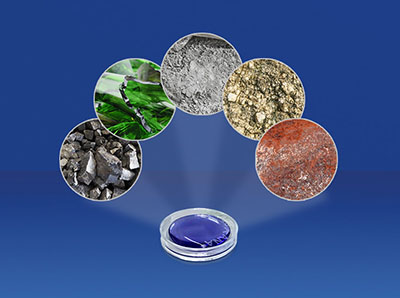


The basic idea of fusion is
the production of samples with the best
possible precision . The best tools are of no
use if the interplay does not work, i.e. in practice fusion are only incomplete or orodispersible tablets glue or
tear.
The fusion depends on many parameters :
· Grain size of the sample
· Selection of the appropriate flux mixture
· Mixing the sample well with the flux before starting
· Solubility of the sample in the flux
· Reproducible temperature of the melt
· Effective stirring, which homogenizes all phases
· Temperature of the pouring cup during casting
· Cooling the orodispersible tablet
· Addition of anti-wetting agent (bromide or iodide)
Here are some application examples :
Cement, plaster, pozzolana, iron oxides, minerals
Approx. 1.5 - 2 g of sample are annealed at 950 ° C in an Al 2 O 3 crucible in a muffle furnace. After cooling and determining the loss on ignition, 1g of the annealed sample is mixed with 8g of flux in a platinum-gold crucible and melted in 15 minutes using the P0 program or the A0 ESG program (1200 ° C).
Limestone, dolomite, bauxite, clay
Like cement, but pretreatment in a muffle furnace at 1050 ° C to constant weight.
Sand, alumina with high Al2 O3 content, refractory materials with high ZrO 2 content
Pretreatment at 1025 ° C (see ISO 12677). Program P1 (approx. 100 ° C hotter than P0) or ESG program A1 (1250 ° C). Highly chromium-containing compounds must be diluted, otherwise the beads will crack. Samples containing at least 50% SiO2 can also be prepared with a high- metaborate (up to 80%) melting agent . A significantly better precision is achieved when determining Fe .
Ashes
Like cement, but pretreatment in a muffle furnace at 815 ° C.
Glass
Pretreatment no or only drying. Melt like cement.
Ferroalloys, metal powder, carbides, filter dusts, slags, sulfide-containing samples
Attention! These materials destroy the platinum crucible if they are melted directly, such as cement. Therefore, the sample must be completely oxidized.
There are three preparation options for this type of sample:
1. Direct method: sample, oxidizing agent and melting agent are weighed into a crucible and first oxidized in a multi-stage program with increasing temperature and then fused.
2. Two-step method: sample and oxidizing agent are weighed into a crucible and oxidized in one step. The lubricant is then added outside the fusion machine and the sample is dissolved in a second step.
3. Internal standard method: Both method 1 and 2 add an internal standard to increase the precision.